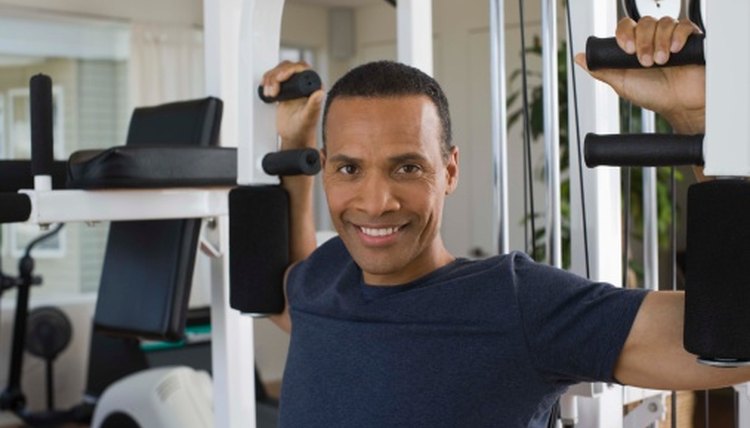Weight Machines That Use Compressed Air to Create Resistance

Weight training is a popular form of exercise that offers various physiological benefits. Regular weight training workouts can enhance your muscle tone, increase strength, improve bone density and strengthen your joints. You can apply a variety of ways to add a strengthening load to your muscles: free weights, body weight exercises, exercise bands and resistance machines are all effective tools. Some resistance machines utilize weights guided by rods while others use air pressure or hydraulics to create resistance.
Design
Compressed air resistance machines use pressurized hydraulic cylinders to provide resistance. The cylinders are sealed so that resistance remains constant or are supplied with air from a compressor so that the resistance can be altered. The variable pressure machines have dials or LCD displays so that you can see the amount of resistance being applied to your muscles, and buttons of increase or decrease the pressure within the cylinders to alter the resistance.
Physiological Benefits
Most free weight and traditional resistance machines involve beginning an exercise from a dead stop. Getting a weight moving from a dead stop is called overcoming the moment of inertia in physics and requires acceleration. In exercise, overcoming the moment of inertia places a rapid and dramatic load on your muscles. At this point your muscles, joints and tendons are at most risk of injury. Because you aren’t actually lifting a weight when you use compressed air gym equipment, there is no corresponding moment of inertia to overcome and therefore less potential for injury. This means that hydraulic exercise equipment is particularly suitable if you have a history of muscle or joint problems — especially compared with more traditional forms of resistance training.
Advantages
Unlike most types of resistance training equipment, compressed air machines are light and relatively portable. The hydraulic cylinders are much lighter and smaller than the weight stacks used in regular resistance machines and therefore the framework used in the manufacture of hydraulic machines does not need to be as strong or heavy. This means that compressed air gym equipment is a viable option when floor strength is a consideration; for example if the gym is located on an upper floor. In addition, compressed air machines are very quiet to use as there are no weights to clang together.
Suitability
Compressed air machines are suitable for a wide range of users but are best suited to use by general fitness enthusiasts and beginner exercises. The machines are simple to operate, safe to use and require very little initial instruction or supervision. The resistance can be changed at the touch of a button and because only the user can see how much weight is being used, using compressed air gym equipment is often less intimidating than free weights and traditional machines where it is more obvious how much weight is being lifted.
Disadvantages
Compressed air gym equipment is less suitable for sports specific training, body building or any other advanced type of workout. The lack of inertia means that strength developed using hydraulic resistance equipment is less likely to transfer to real-world strength where inertia is unavoidable. The feel of compressed air exercises is quite different to that of lifting real weights and some exercisers find this off-putting.
References
- Hoeger WW, Hoeger SA. Principles and Labs for Fitness and Wellness. Cengage Learning; 2015.
- Wirth K, Keiner M, Hartmann H, Sander A, Mickel C. Effect of 8 weeks of free-weight and machine-based strength training on strength and power performance. J Hum Kinet. 2016;53:201-210. doi:10.1515/hukin-2016-0023
- Spennewyn KC. Strength Outcomes in Fixed Versus Free-form Resistance Equipment. Journal of Strength and Conditioning Research. 2008;22:75.
Writer Bio
Patrick Dale is an experienced writer who has written for a plethora of international publications. A lecturer and trainer of trainers, he is a contributor to "Ultra-FIT" magazine and has been involved in fitness for more than 22 years. He authored the books "Military Fitness", "Live Long, Live Strong" and "No Gym? No Problem!" and served in the Royal Marines for five years.
